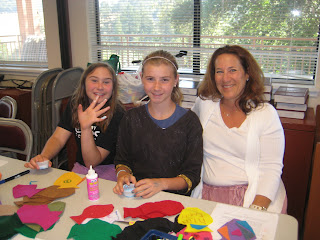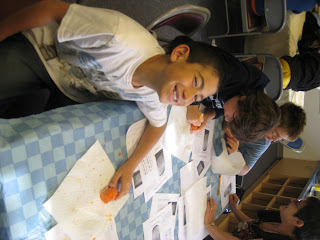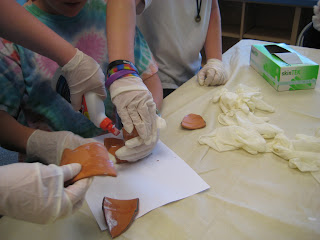Following the skit, the classes divided up into three groups: Omanut, Teva, and Shira/Academy. Each followed a schedule for the two stations of the Fair they would visit. The first station was our "Edot Bazaar" in the Beit Knesset. Tables were set up as "booths" and each booth shared a game or arts&crafts project from various Edot we had studied during the year. There was also a food booth, sharing tastes of foods from the Edot.
As you walked into the Beit Knesset, the first booth was the "CHAMSA" booth. The Edot students staffing this booth shared with the visitors the origins of the chamsa (a Muslim amulet in the form of a hand, adopted by the Jews of Middle Eastern and North African communities), and how they were traditionally decorated by the Jews.
Continuing on to the next booth, visitors were instructed how to play the Ethiopian game of QILEBLEBOSH, enjoyed by children in the Beta Yisrael (Ethiopian Jewish) community. It's a lot like the American game of Jacks, but you can only use one hand, and it's played with stones.
The next booth to visit was the STOP game booth. This was a game originally played by Spanish Jewish children, and was brought to Mexico when they fled the Spanish Inquisition. It was originally played orally, but today it is played with paper and pencil. One person begins to slowly recite the letters of the alphabet, and a second person yells "Stop!" The players must then begin to write down words in certain categories that begin with the letter the reciter was saying when the second person yelled, "Stop!" The categories are colors, flowers, fruits, countries, and first names. The player who finishes first yells "Stop!" and all the other players must put down their pencils. Points are awarded for each category entry that is correct, and extra points are given to the player who finished first.
(No one said you couldn't do two things at once in the booth - playing STOP and weaving a yarn basket are two very enjoyable activities!)
Right next to the STOP booth, visitors could learn how to weave yarn baskets. During our studies about the Beta Yisrael (Ethiopian Jewish community), we learned that they were famous for their skill at basket weaving. To accommodate the short time available for the Edot Fair booths, visitors were taught how to weave simple baskets using multi-colored yarn and foamies. The results were quite impressive.
In fact, this booth was so popular, that we ran out of foamies and yarn on the first day of the Fair. Fortunately, we had materials available from an art project from a previous Edot Fair, called Jeta de la Mezuzah. Even though we hadn't specifically studied about Moroccan Jews this year (we will next year!), we did study about the Sephardi (Spanish) Jewish community, and specifically learned about the Crypto-Jews of Spain. While still in Spain, those Jews who converted to Christianity but secretly continued to practice Judaism, carried on their belts cloth pouches with two Christian prayers in them - the Lord's Prayer and the Hail Mary. Spanish Christians believed this protected them from evil wherever they traveled. If suspected of being "Judaizers," these Crypto-Jews could show their adherence to the Christian faith by wearing the "jeta's." But sewn into the lining of these pouches, were the "Sh'ma/V'Ahavta prayers" - the 22 lines inserted into the mezuzah. When many Crypto-Jews escaped to Morocco, across the Strait of Gibraltar from Spain, they brought with them these pouches, and to this day many Moroccan Jews wear them (without the Christian prayers!) or hang them on their doorposts. Today, the jeta's are decorated with the four-letter name of God and the owner's name, along with flowers or bird decorations, or geometric patterns.
The final craft booth was the Yemenite copper wire bracelet booth. During our unit of study about the Yemenite Jewish community, we learned that the Arab Muslims believed that evil spirits resided in metal, and melting and re-shaping metal would allow these spirits to escape. Therefore, all metal crafts, including the forging of weapons and jewelry-making, were left for the Jews to do. The Jews of Yemen became famous especially for their silver and copper wire jewelry. And because both Jews and Muslims believed that evil spirits were attracted to round objects like moths are to flames, beads were almost always placed on their clothing and jewelry, in the belief that the evil spirits would be attracted to them, but then become imprisoned in the round shape. Our booth visitors became Yemenite jewelers, creating beautiful copper wire, beaded bracelets.
The last game booth was the one most visited by the Fair participants (not counting the food booth!), according to certain statisticians in the class. This was the DOSA game booth, a betting card game played by the Iraqi Jews during the holiday of Purim. According to the Book of Esther which tells the Purim story, it was sheer luck that saved the ancient Mesopotamian Jewish community from certain annihilation. Therefore, this card game requires no skill at all - just luck!
Finally, as mentioned above, our Edot food booth was very, very popular. Visitors were able to taste foods from the edot we had studied during the year, and the consensus was that these were all quite delicious.
There was Yemarina Yewotet Daabo, a honey bread from Ethiopia, eaten by Beta Yisrael members as one of the foods breaking their fast after the Sigd Festival...
and Fattoush, a Sephardi Jewish bread salad, which was once fed between meals to a young bride (who might be only 9 or 10 years old) who was considered to be too thin, to fatten her up for the wedding.
Or you might try Sesame cookies popular amongst all the Middle Eastern and North African Edot, since sesame seeds in Jewish tradition are symbolic of the manna that God sent for the Israelites to eat as they wandered in the wilderness, following the Exodus from Egypt.
There were also Sesame bars popular with Sephardi Jews in Iraq, date patties from Iraq (chopped dates mixed with flour and fried in butter or margarine), Bint Al-Sahn (a honey "cake-pie) and Zemeta (a sweet mixture of crushed roasted garbanzo beans, sesame seeds, cinnamon and sugar) from Yemen, and a warm Mengedrah rice and lentil stew from Sephardi Jews in Syria. And there were lots of roasted garbanzo beans, a favorite snack of all the Jewish communities in the Middle East and North African countries.
The second station that the classes visited during the Fair was "The Ballad of Diego Leon" in one of our classrooms. This ballad (called a "romanza" in medieval Spanish), was typical of the ballads Jews heard the Spanish singing. They borrowed these ballads, and gave them a "Jewish twist," adding specifically Jewish characters and situations into them. This particular ballad shared the story of a young man, Diego Leon, who falls in love with a lady named Donna Juana in the city of Granada. They want to marry (they're both very, very young!), but Don Pedro, Juana's father, refuses to allow them to do so because Diego won't be able to support his daughter (some things never change!). To keep Diego away from Juana, he hires six strong men, who are ordered to find Diego and "take care of him once and for all!" They find Diego on the top of a mountain, where he has fled. When he sees them coming, he jumps off the mountain into the sea. Some say that he survived the jump and swam to the shore. He then searches for his lady love on the street where she lives. When he can't find her at first, he despairs that she has changed her mind, and doesn't love him anymore. But no, the ballad ends with her "flying" down the stairs of her home, and they are reunited. Her father, Don Pedro, realizes that "love conquers all" and gives them a lavish wedding.
The CD we played of this ballad is part of a wonderful unit of study about the Jews of Spain called "Out of Spain," by Andree Aelion Brooks, which I highly recommend. Our students had a good time acting out the ballad to the obvious enjoyment of our audience.
Diego professes his love for Dona Juana...
"I don't care what my father will say, I want to marry you!"
Diego greets Don Pedro, getting ready to ask for Dona Juana's hand in marriage...
No - you cannot marry her - my daughter is too young!
Watch out Diego - here come the strong men...
They find Diego on top of the mountain...
The story ends happily. The lovers are reunited, and celebrate at a lavish wedding together with Don Pedro and the strong men. Take a bow actors!
Following the Fair's activities, all the classes met back downstairs in the Amphitheater, to finish our final weekday session with a joyful and spirited t'fila session led by Rabbi Greninger and Elaya, our Shira teacher. As we waited to begin t'fila, there were still a few moments left to squeeze in some basket weaving. But once it started, our hands and feet and minds were all focused on singing and dancing together.
And we finished our weekday t'fila, as we always do, with the singing of the "Hashkiveinu" prayer, as we all stood in a large circle.
I'd like to extend a very big THANK YOU to all the parent volunteers from our Edot class, who took time from your busy lives to help make this Fair such a great success by either preparing recipes for our food booth at home, and/or helping to staff our game and crafts booths together with our Edot students. A big thank you also goes out to Rachelle for photographing the events of the Fair. Thank you to Josh, our Wednesday Edot satellite teacher who came both Tuesday and Wednesday, and to our Wednesday TA's, Maddy and Ben. And last, but not least, none of this could have happened without the energy and enthusiasm of the Edot students themselves. Yasher Koach to you all.
















































